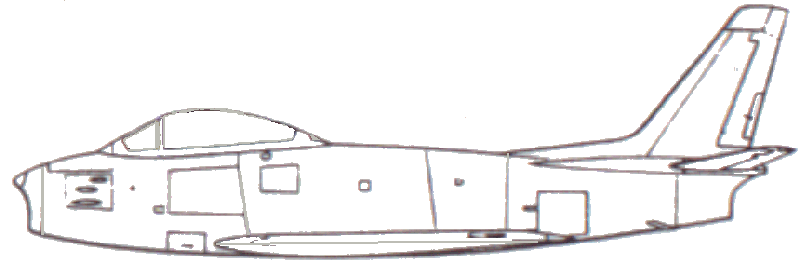

December 99 - I was very enthusiastic when I saw a prototype of this plane on the Dortmund fair last spring. So I ordered and received the kit of the Schreiner GFK Modell - F-86 in June already, mine is the third kit ever. This was a bit too early, as the supplier was not yet ready making the air channels and bulkheads for the fan unit installment.
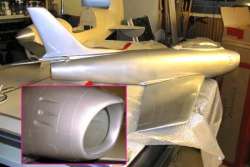
(click on the pics to see the high-quality
version)
The airplane can be "assembled" right off the box
After receiving these parts, I began building some weeks ago, though the Schübeler-ducted fan (carbon fibre) is still missing. The planning for the further setup is a brushless motor (probably a HP) with appropriate controller and 18 cells RC2000.
This model is made completely from fiberglass
and is lacquered silver in the mold. Mine has some poor lacquered spots in the
rear fuselage. This problem was settled to my complete satisfaction in form of a
discount however... The surface has all details like rivets etc.
The kit contains:
- a very fine detailed, silver fuselage
- the finished one-part wing of the same kind and ready-made ailerons
("Elasto-Flaps")
- the stabilizers/elevators of the same kind
- a clear canopy
- plywood bulkheads (to be jigsawed) to mount the ducted fan unit.
The air channels must be ordered separately.
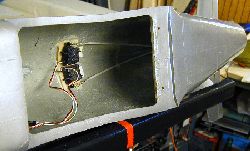
Servo installation in the back of the fuselage. The
ducted fan will be fitted just in font of the servos later.
With this kind of kit, "Building" is just a few works, like fitting R/C and fan unit, finishing the wing mounting etc.
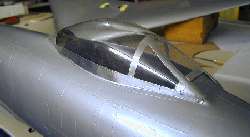
I covered the canopy frame with aluminium tape.
March 00 - Meanwhile the F-86 is almost ready for flight. The power unit consists of the components: Schübeler-DF, Plettenberg motor HP 220/30/A4 S P4 (brushless) und ESC Kontronik 3sl 40-14-32.
There is not much more to say regarding building. Let pictures speak. :)
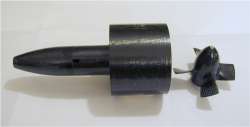
The Schübeler 90 mm DF-unit...weight is less then one cell of
RC2000 (!)
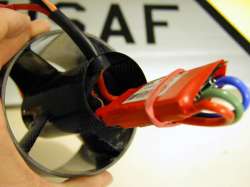
This is the way the ESC is mounted behind the motor. It will be
covered by the cone (see above
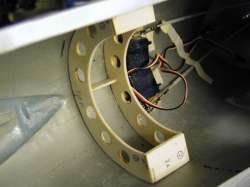
The bulkheads for the DF-unit are in place in the fuselage
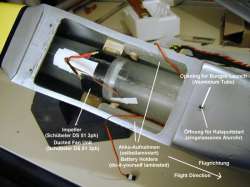
The components in the "belly" of the F-86...
The measurements of the static thrust some days ago where more or less disappointing. With 18 cells of RC2000 it is just about 1,200 grams. Now I am looking for the reasons. Perhaps I will have to add 2 cells or use "zapped" ones.
The F-86 did not fly yet.
Some details:
Wing Span: 1,200 mm (47")
Weight: approx. 3,100 g
Current: approx. 33 A
Static thrust: about 1,200 g
October 00 - The maiden flight took place in April in windy weather with above setup. The take-off was shaky but everything else was ok. I only had the feeling that a bit of additional power might be a good idea, so I added 2 cells to the existing packs. Static thrust increased to little more than 1,400 grams at 38 Amps current. Flying time is a bit below 4 minutes.
Thereby the model flew really excellent, what was shown also to the public (by "my" show pilot Chris Abeln however) at the EDF-meets in Gronau and Hude as well as on the Aspach Meeting. Speed (estimated by the experts) was in the range of 160 km/h at level flight and surely up to more than 200 km/h after a dive. The airplane also climbed very well and powerful despite its high weight. Behaviour during flight is without any problem. But it is a good advice to de-activate the gyro during speed flight as otherwise a not critical but also not nice yaw will occur.
Writing about the gyro...it is a real help for take-off and landing. Both is much less critical.
To keep it short: this modell with an approprate powertrain is capable to also excite old ".60-powered-airplane-from-the-70s-Pilots" ;-) and to convince them of the power and performance of today's EDF itself.
The nose is very "sensitive",so it was crumpled by a bad incident. The rest of the airplane kept without damage. The air inlet inevitably gets also damaged however, so that quite extensive repairs were necessary.
Because of these repairs the model finally weighted about 3,400
grams. So landings did not become any easier. Help was found by rising the
ailerons by 13 mm and at the same time activatig the gyro.
The end was there on September 23. A deep, fast pass + a deep sun + wrong
pilot's reaction are a deadly combination. The F-86 vertically crashed into a
field with an estimated speed of 180 km/h...Model, fan, gyro, all battery packs
were scrap.
The same evening I ordered everything new...that is why:
...the story is finally continued. ;-)
November 01 - Here are two pictures of my second F-86, almost finished. The equipment is the same as the first had, with two exceptions: the ducting is a special construction by Uwe Heidemann and I use one more cell (21 now). I tried to bring some weathering onto the surface, what works quite well with two tissues (one with dull black acrylic paint, one with nitro thinner) as you can see on the pics.
To be continued...
| Home |